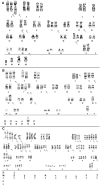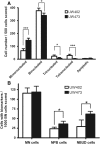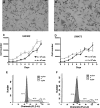Chromosomal heterogeneity and instability characterize pediatric medulloblastoma cell lines and affect neoplastic phenotype
- PMID: 23325114
- PMCID: PMC3967617
- DOI: 10.1007/s10616-012-9529-z
Chromosomal heterogeneity and instability characterize pediatric medulloblastoma cell lines and affect neoplastic phenotype
Abstract
Chromosomal heterogeneity is a hallmark of most tumors and it can drive critical events as growth advantages, survival advantages, progression and karyotypic evolution. Medulloblastoma (MB) is the most common malignant central nervous system tumor in children. This work attempted to investigate chromosomal heterogeneity and instability profiles of two MB pediatric cell lines and their relationship with cell phenotype. We performed GTG-banding and cytokinesis-block micronucleus cytome assays, as well as morphological characterization, cell population doubling time, colony-forming efficiency, and chemo-sensitivity assays in two pediatric MB cell lines (UW402 and UW473). Both MB cells showed a high chromosomal heterogeneity. UW473 cells showed ~2 fold higher both clonal- and non-clonal chromosomal alterations than UW402 cells. Besides, UW473 showed two clonal-groups well-differentiated by ploidy level (<2n> and <4n>) and also presented a significantly higher number of chromosomal instability biomarkers. These results were associated with high morphological heterogeneity and survival advantages for UW473 and proliferation advantages for UW402 cells. Moreover, UW473 was significantly more sensitive to methotrexate, temozolomide and cisplatin while UW402 cells were more sensitive to doxorubicin. These data suggest that distinct different degrees of karyotypic heterogeneity and instability may affect neoplasic phenotype of MB cells. These findings bring new insights into cell and tumor biology.
Figures





Similar articles
-
New Insights in the Cytogenetic Practice: Karyotypic Chaos, Non-Clonal Chromosomal Alterations and Chromosomal Instability in Human Cancer and Therapy Response.Genes (Basel). 2017 Jun 3;8(6):155. doi: 10.3390/genes8060155. Genes (Basel). 2017. PMID: 28587191 Free PMC article. Review.
-
Biological characterization of the UW402, UW473, ONS-76 and DAOY pediatric medulloblastoma cell lines.Cytotechnology. 2019 Oct;71(5):893-903. doi: 10.1007/s10616-019-00332-3. Epub 2019 Jul 26. Cytotechnology. 2019. PMID: 31346954 Free PMC article.
-
Functional analysis of HOXA10 and HOXB4 in human medulloblastoma cell lines.Int J Oncol. 2017 Dec;51(6):1929-1940. doi: 10.3892/ijo.2017.4151. Epub 2017 Oct 10. Int J Oncol. 2017. PMID: 29039487
-
Polo-Like Kinase 1 Pharmacological Inhibition as Monotherapy or in Combination: Comparative Effects of Polo-Like Kinase 1 Inhibition in Medulloblastoma Cells.Anticancer Agents Med Chem. 2017;17(9):1278-1291. doi: 10.2174/1871520617666170213112904. Anticancer Agents Med Chem. 2017. PMID: 28270075
-
Cytokinesis-Block Micronucleus Cytome Assay Evolution into a More Comprehensive Method to Measure Chromosomal Instability.Genes (Basel). 2020 Oct 15;11(10):1203. doi: 10.3390/genes11101203. Genes (Basel). 2020. PMID: 33076531 Free PMC article. Review.
Cited by
-
New Insights in the Cytogenetic Practice: Karyotypic Chaos, Non-Clonal Chromosomal Alterations and Chromosomal Instability in Human Cancer and Therapy Response.Genes (Basel). 2017 Jun 3;8(6):155. doi: 10.3390/genes8060155. Genes (Basel). 2017. PMID: 28587191 Free PMC article. Review.
-
Molecular characterization of Wnt pathway and function of β-catenin overexpression in medulloblastoma cell lines.Cytotechnology. 2018 Dec;70(6):1713-1722. doi: 10.1007/s10616-018-0260-2. Epub 2018 Oct 29. Cytotechnology. 2018. PMID: 30374857 Free PMC article.
-
Chromosomal Heterogeneity of the G-401 Rhabdoid Tumor Cell Line: Unusual Partial 7p Trisomy.Front Med (Lausanne). 2019 Aug 30;6:187. doi: 10.3389/fmed.2019.00187. eCollection 2019. Front Med (Lausanne). 2019. PMID: 31544104 Free PMC article.
-
Oxamate, but Not Selective Targeting of LDH-A, Inhibits Medulloblastoma Cell Glycolysis, Growth and Motility.Brain Sci. 2018 Mar 30;8(4):56. doi: 10.3390/brainsci8040056. Brain Sci. 2018. PMID: 29601482 Free PMC article.
-
Perillyl alcohol for pediatric TP53- and RAS-mutated SHH-medulloblastoma: an in vitro and in vivo translational pre-clinical study.Childs Nerv Syst. 2021 Jul;37(7):2163-2175. doi: 10.1007/s00381-021-05115-w. Epub 2021 Apr 22. Childs Nerv Syst. 2021. PMID: 33885911
References
-
- Bayani J, Zielenska M, Marrano P, Kwan Y, Taylor MD, Jay V, Rutka JT, Squire JA. Molecular cytogenetic analysis of medulloblastomas and supratentorial primitive neuroectodermal tumors by using conventional banding, comparative genomic hybridization, and spectral karyotyping. J Neurosurg. 2000;93:437–448. doi: 10.3171/jns.2000.93.3.0437. - DOI - PubMed
LinkOut - more resources
Full Text Sources
Other Literature Sources
Research Materials
Miscellaneous

